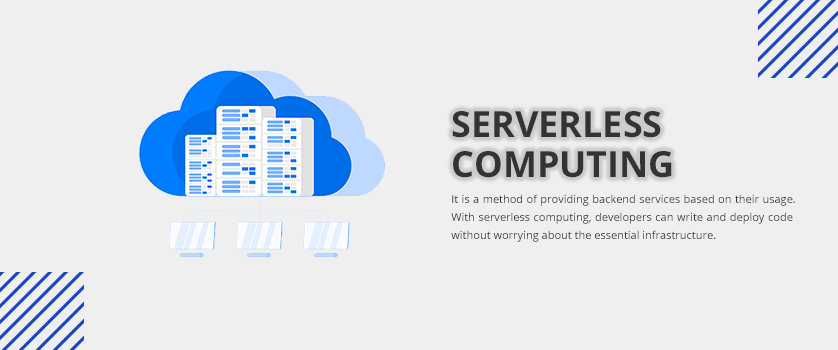


It is a method of providing backend services based on their usage. With serverless computing, developers can write and deploy code without worrying about the essential infrastructure. An organization that picks a backend service from a serverless vendor is charged based on their computation, and it doesn't have to reserve and pay for a fixed amount of bandwidth or number of servers, as this service scales automatically. However, as the name suggests Serverless, physical servers are still required but developers do not need to give more attention to these physical servers.
Earlier, if an organization had to build a web application, it had to use physical hardware to set up a server, which was a time-consuming and expensive option.
Then comes Cloud computing. In Cloud computing, organizations can purchase server space on rent remotely. Usually, organizations purchase excessive space hoping that traffic surge in the future will not lead to the breaking of their application. However, most of the time the amount paid for excessive space goes in vain. Contrary to this, Cloud vendors come up with an auto-scaling model to deal with such difficulties.
Serverless architecture and serverless computing are the same thing and behave like Function as a Service (FaaS). It is a software design pattern where developers can host their application via third-party services, eliminating the need for a software server and self hardware management by the organization. The advantage of serverless architecture is that instead of posting a complete application, it breaks the application into individual or smaller functions that can be scaled individually.
Developers rely on serverless architecture to execute specific functions. Because of this, cloud service providers offer Functions as a Service (FaaS). Below, you can see how functions are written and executed in a serverless way.
Following steps take place to use serverless computing:
Chatbots are widely popular for providing customer service and also help sales teams communicate with the customer and prospect when team members are not available. Moreover, they provide valuable output and cost relatively minimal but they can be turned into a single function application.
Now such chatbots can be hosted on Virtual Machines, but they are not the preferred choice for this as they increase the operational cost. That’s why serverless platforms are preferred by teams worldwide. The advantage of using a serverless platform is that the individual features can be hosted separately on the serverless architecture while the rest of the features or the entire application, excluding a single function, can be deployed on VMs.
|
Basis of Comparison |
Serverless Computing |
Cloud Computing |
|
Meaning |
For users, the server is invisible as the Cloud provider takes care of the setup, capacity planning, and server management. |
On-demand computing services like computer power, database storage, applications, and other IT resources are delivered over the internet. |
|
Role of Servers |
The worries of configuration and management of resources disappear as the Cloud service provider does all this for you. |
You need to buy a specific space over the Cloud, and at the same time, you need to manage and configure Cloud resources on your own. |
|
Utilization of Hosting Resources |
The various functions of the application are split out into separate containers and hosting resources are allocated to the specific functions instead of hosting a complete application. |
A complete web application is hosted on the Cloud that requires huge space. And to deal with sudden traffic surge, you need to buy more space in advance. |
|
Allocation of Resources |
Serverless computing is more precise than Cloud computing as it allocates exact resources to execute a particular function. For example, if an application needs 3.45 GB or 3.75 GB of RAM to complete a task, serverless computing releases the exact resources. Neither more nor less. |
With traditional Cloud computing, you need to buy additional space in advance so that the application does not fail. For example, you may add 2GB or 4GB of RAM additionally so the application has sufficient memory available for peak traffic or usage. |
|
Cost |
Serverless computing offers flexible pricing. You pay only for what you use. For instance, if your application takes 2.45 GB of RAM then you pay only for the memory you have used. |
As you buy a dedicated space on Cloud, you need to comply with rigid pricing even if you’re not using it fully. Suppose you buy 8GB of space and are using only 4GB or 6 GB in peak times, you still have to pay for 8GB. |
If you want to know which platform should you use, look at the comparison below:
|
Basis of Comparison |
AWS Lambda |
Azure Functions |
Google Cloud Functions |
|
Language Support |
JAVA, Go, PowerShell, Node.js, C#, Python, and Ruby. |
C#, F#, JavaScript, JAVA, PowerShell, Python, and TypeScript. |
JavaScript, Python, Go, JAVA. |
|
Free Offering |
1 million executions per month. |
1 million executions per month. |
2 million executions per month. |
|
Maximum/Minimum Execution Time |
Maximum up to 15 minutes. |
Up to 60 minutes, with a premium plan else 10 minutes. |
Minimum 1 minute, maximum 9 minutes. |
Serverless computing allows you to run your applications as a function in the Cloud. The best part of this technology is that it only charges for the compute time that your application uses. Serverless computing is based on event-driven architecture, which makes it easy to scale and perform. And the benefits do not stop here because as a developer you can shift your attention towards more significant things other than scaling, configuration, and management.